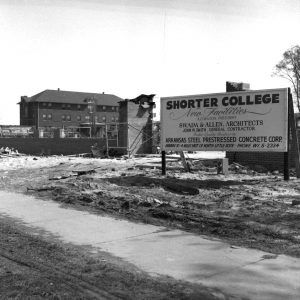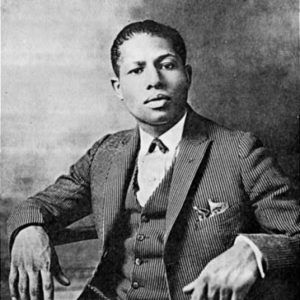calsfoundation@cals.org
Shorter College
aka: Bethel Institute
Shorter College in North Little Rock (Pulaski County) is a two-year institution of higher learning with a liberal arts curriculum that has expanded to include para-professional programs. Founded as Bethel Institute in 1886 by the African Methodist Episcopal Church (AME) to educate former slaves and to train teachers, the college occupies three and a half blocks at 600 Locust Street, east of Interstate 30. A thirty-three-member board of trustees, chaired by the bishop of the AME’s Twelfth Episcopal District in Arkansas and Oklahoma, oversees the school.
Classes were first held in the basement of Bethel AME Church at 9th and Broadway in Little Rock (Pulaski County) on September 15, 1886. Rising enrollment led to acquisition in 1888 of a two-story frame building at 11th and Gaines streets in Little Rock. Future civil rights pioneer Mary Burnett Talbert began her career teaching at Bethel. In 1891, Bethel relocated to Arkadelphia (Clark County). The college was renamed in 1892 in honor of Bishop James A. Shorter, who organized the Arkansas Annual Conference of AME churches in 1868. Shorter University was chartered on May 18, 1894. In 1896, Shorter purchased land in Argenta, which was then the Eighth Ward of Little Rock. Shorter maintained campuses for a year in both Argenta and Arkadelphia until it moved all its operations in 1898 to Argenta (now North Little Rock). Shorter changed its name to Shorter College in 1903. That year, the college also erected Tyree Hall, a three-story brick building that housed classrooms, offices, a library, and boys’ dormitories.
By 1917, Shorter featured three brick buildings and one frame structure for students enrolled in courses from the third grade to college. It was the only school in North Little Rock that offered high school diplomas for Black students until 1928. The college provided a four-year curriculum until 1955. Conner Hall housed girls’ dorms, classrooms, a 600-seat assembly hall, and a dining room and kitchen. Coley Hall also housed girls’ dorms, classrooms, and a library. Under a strict dress code, girls wore navy blue serge suits with matching Oxford hats, and boys wore navy blue jackets, trousers, and caps.
Although the college has struggled financially throughout its existence, it has educated many AME clergy and lay leaders. Among its graduates are Scipio A. Jones, a former slave and civil rights lawyer, and Daisy Gatson Bates, a civil rights champion and supporter of the 1957 integration of Little Rock Central High School. During the first half of the twentieth century, Shorter relied on a combination of local and national funding sources in addition to tuition. The General Education Board in New York, founded by John D. Rockefeller and Frederick T. Gates, regularly inspected the campus and provided grants that helped rehabilitate Tyree Hall and provide for other needs. A report in 1920 noted that the school was burdened with debt but had pledged to match “dollar-for-dollar” the funds provided by the General Education Board. Enrollment had topped 850 in 1919–20. However, the 1920 report also noted that the “dormitories were crowded beyond the proper standard for educational work and about 200 girls were refused admission.”
Financial challenges prompted Bishop William R. Wilkes and college president Theophilus D. Alexander to make Shorter a two-year college in 1955. Tyree Hall was razed in 1957 and replaced with a new building, Sherman-Tyree Hall, dedicated in May 1961. Bishop Odie L. Sherman, board of trustees chairman, headed the fundraising drive. Construction in the 1960s and 1970s replaced dilapidated structures with new facilities for a cafeteria, an administration building, a library, a student center, dormitories, and a human resources complex and auditorium. As of 2012, the campus had eight buildings. In 1981, Shorter received full accreditation, which enabled students to transfer credits directly to four-year institutions. However, internal political division and debt in the 1980s and 1990s crippled the school administration, forced layoffs, and harmed Shorter’s reputation. In 1989, Dr. Katherine P. Mitchell was chosen by the board of trustees as the first woman president of the college. Under her leadership, the college made positive gains, including the completion of the Henry A. Belin Health-Plex and the Alexander-Turner Child Development Center. In addition, the Shorter Bulldogs won Arkansas State Junior College basketball championships and advanced in the Region II National Junior College Tournament under Coach Charles Baker.
Dr. Irma Hunter Brown, a 1958 Shorter graduate who became president of Shorter in 1997, faced a crisis after the college lost accreditation and access to federal funds the next year. Buildings were closed, and enrollment plummeted to its lowest ever. An agreement with the University of Arkansas at Pine Bluff (UAPB) in 2000 helped turn things around by allowing students to take accredited courses at Shorter; by 2012, about 100 students were enrolled in general education and certificate programs. The board of trustees named Dr. Cora D. McHenry as president in 2002. Progress was made toward reopening buildings, retiring debts, restoring financial assistance to students, and developing effective fundraising campaigns to strengthen the college’s financial footing. Behind all these efforts was the goal of restoring Shorter’s accreditation through the North Central Association of Schools and Colleges. In May 2007, the college awarded associate of arts degrees in General Studies for the first time since losing accreditation. Former president Mitchell later returned to lead the effort to gain candidacy for accreditation by the Transnational Association of Christian Colleges and Schools. Candidacy was attained in 2011, with accreditation following in 2013.
Jerome Green took the helm of Shorter in 2012, and he led until his death in 2024. By early 2014, the college had a staff of forty. Enrollment in fall 2014 was 406 students; in fall 2022 enrollment was 632 students. In 2023, plans were announced for a $1.8 million technology hub, funded in part by a federal grant, housed in the nearby historic Rock Island Argenta Depot, which the college had been leasing from the city since 2023. The site will be used to offer computer courses and house a credit union.
For additional information:
Harper, Misti Nicole. “James Alexander Shorter.” Pulaski County Historical Review 63 (Fall 2015): 109–110.
Lovett, Bobby L. “African Americans, Civil War and Aftermath in Arkansas.” Arkansas Historical Quarterly 54 (Autumn 1995): 304–358.
McSwain, Bernice Lamb. “Shorter College: Its Early History.” Pulaski County Historical Review 30 (Winter 1982): 81–84.
Roberts, Jeannie. “NLR’s Shorter College Revives.” Arkansas Democrat-Gazette, February 9, 2014, pp. 1B, 8B.
Shorter College. http://www.shortercollege.edu/ (accessed September 13, 2024).
Shorter College File. North Little Rock History Commission, North Little Rock, Arkansas.
Shorter College General Microfilm. Arkansas State Archives, Little Rock, Arkansas.
Snyder, Josh. “Shorter College Plans Tech Hub.” Arkansas Democrat-Gazette, December 4, 2023, pp. 1A, 3A. Online at https://www.arkansasonline.com/news/2023/dec/04/18m-technology-hub-to-revitalize-east-broadway/ (accessed September 13, 2024).
Cary Bradburn
North Little Rock History Commission
 Methodists
Methodists Post-Reconstruction through the Gilded Age, 1875 through 1900
Post-Reconstruction through the Gilded Age, 1875 through 1900 Irma Brown
Irma Brown  Shorter College
Shorter College  Shorter College Construction
Shorter College Construction  Phonnie Trent
Phonnie Trent 



I served as interim president from 2009 to 2010. It was an honor to fill the position, and I remain a faithful friend to this time-honored institution.